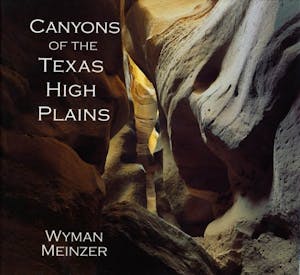Wyman Meinzer’s photography takes us places we’ve never been and probably will never go. He captures on film some of the most remote and beautiful spots in Texas so that city slickers who lack the wherewithal to ride a mule into the desert may enjoy them. Find out more about Meinzer’s artistic vision and his love for the Texas terrain.
 texasmonthly.com: You are regarded as an authority on natural landscape and wildlife photography. What makes your work so distinctive?
texasmonthly.com: You are regarded as an authority on natural landscape and wildlife photography. What makes your work so distinctive?
Wyman Meinzer: In regards to my wildlife photography, I believe my upbringing in a ranch environment has been a positive influence on the style of images that I produce. In my youth, I was interested in the natural fauna across the state and had the opportunity to study and hunt most of the creatures indigenous to the rolling plains on the ranch where I lived. During my years at Texas Tech University, I studied wildlife management and became involved in wildlife research doing extensive fieldwork on coyotes. With this portfolio of experience, I entered the photography arena and offered images that displayed a more intimate insight into the creature and its natural history. I think my first two books Roadrunner and Coyote offer evidence of this fact.
My landscape work is quite unique in that I try to explore regions and areas of Texas that other people tend to avoid. My work applauds the largely unknown sanctuaries of this state ranging from the Panhandle to Far West Texas and Mexico. I have no qualms about getting into these unfettered regions. Whether it takes mules, horses, backpacking, or aircraft, I will do what it takes to get the images I seek. For instance, my upcoming book Desert Sanctuaries: The Chinatis of The Big Bend, published by Texas Tech University Press, is a compilation of photos taken mostly after weeks of flying into the most remote regions of the Big Bend in a chopper. I covered in a week out of a chopper what an individual on foot could not do in a month. The images included in the book reflect years of work in that region of the state. I love the state and national park land in Texas, but my excitement is at its apex when I am in areas mostly unseen by the average human eye. Texas has so much beauty and wonder, and I want to experience all that I can while I can.
In regards to photographic technique, I think that most landscape photographers have the same basic approach that is necessary to offer the viewer tasteful and beautiful images. It is site selection that brings my work into a different light.
texasmonthly.com: From where does your love of the outdoors stem?
WM: From my earliest memories I have always been an outdoor enthusiast, and I am sure it is a function of my upbringing in a rural setting. Having parents that encouraged participation in the outdoors was a significant factor as well.
texasmonthly.com: How does your skill set differ from that of other types of photographers?
WM: I had an above-average interest in photography as a young boy but did not think much about it at that point. I did not have any formal schooling in photographic techniques. I was fortunate enough to develop my own style without the interference of outside forces at a critical point in the learning curve. “Woodsman” is a term often used by some individuals in describing my experience when I am involved in my outdoor work. I consider this term a noble and honorable description of my approach to outdoor photography. Actually, I think it defines being somewhat savvy with the outdoors. I accept that title!
texasmonthly.com: Can you tell if a picture is going to be good or not the moment you snap it?
WM: I will not expose an image or images if I don’t think it will convey the message that I intend. Most of the time, I like the results that I see.
texasmonthly.com: What are you trying to accomplish with your pictures? What do you hope people take from your work?
WM: I hope that people will realize that so much beauty and intrigue lies beyond the boundaries of our roadways and parks systems. I sometimes feel that beyond the fences of our parks, people think that nothing more of our state needs to appreciated and preserved. It is a misconception that could eventually prove fatal to the natural and historical heritage of Texas, if not America.
texasmonthly.com: You were named the official photographer of Texas in 1997. What does this job entail?
WM: It is not a job per se. I like to think that I was designated the state photographer because of my overall passion for the beauty of this state. Unlike many photographers, I no longer specialize in one aspect of Texas. My appreciation encompasses all aspects of our state including the land, the people, the wildlife, the weather, the state history, and an often overlooked segment—the sky.
texasmonthly.com: Do you think you’ll ever run out of material in Texas?
WM: This state is the most diverse in all of America, and I doubt I will live long enough to even come close.
texasmonthly.com: What projects are you currently working on?
WM: I am excited to be involved with three new books. One is a work with author and poet laureate of Texas, Walt McDonald, of Lubbock. The book is entitled Great Lonely Places of the Plains and will feature Walt’s poetry accompanied by my images. Texas Tech University Press will publish this book.
A second work is a major coffee table book celebrating the history of windmills. I will be working with Coy Harris, the director of the American Wind Power Center in Lubbock, on this project. The book will feature photos of rare windmills in the American Wind Power Collection as well as images of windmills in the current physical environment from around the region. Texas Tech University Press will publish it.
The third book is a collection of words and photos with my wonderful friend and Texas icon John Graves. We are doing a book on the Texas Hill Country with the University of Texas Press. It is actually an expansion of the article that John did for National Geographic in 1999. John and I collaborated on Texas Rivers, and John wrote the introduction for two of my previous books Texas Sky and Eyes on Texas. I consider it a great honor to be working with John once again.







